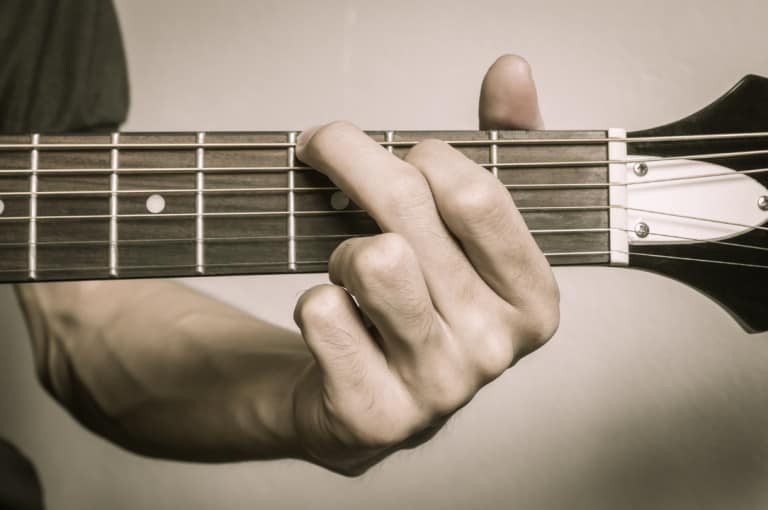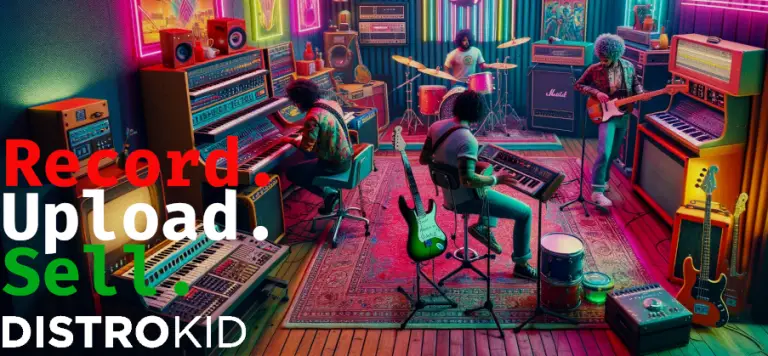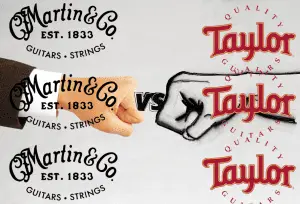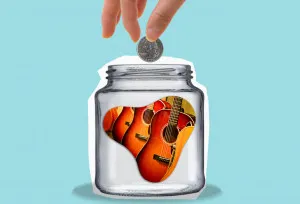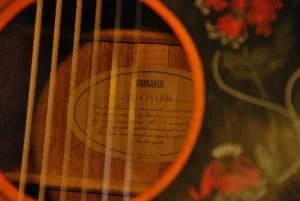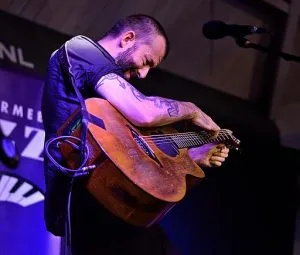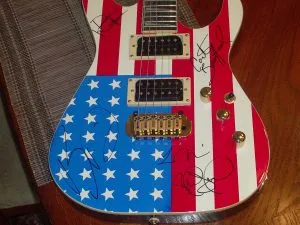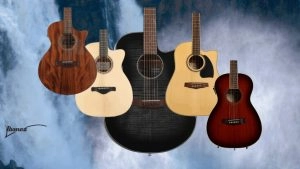Where do you get started when you first pick up a guitar?
As a self-taught guitar player who gigged in bands for many years, the first thing I wanted was to strum a few chords. Then take those chords and play a few things my friends would recognize as songs.
With these five shapes, you can create all the main chords you’ll need to rock out chord progressions. You’ll have the patterns to move around the neck and build your guitar empire.
What are the 7 CAGED Basic Guitar Chords?
Learning music is all about learning patterns. But the language of those patterns can be confusing to a budding self-taught guitarist. Why? Everything references the piano keyboard and that’s not cool.

A fifth chord, for instance, is one of the most basic and ubiquitous guitar chord structures around (power chords). But what’s a fifth? Five notes up on the keyboard from your root note, you’ll find the fifth. Three up, you’ll find the third. And so on it goes.
But the guitar’s fretboard isn’t laid out exactly like that. So you’ll get confusion creeping in. When you’re confused, you don’t want to practice. The solution is the CAGED method and movable shapes.
The beginner guitar chords that make up the CAGED mnemonic are below, along with chord diagrams to help you shape them:
C Major Chord
The C major chord is one of the first chords you should learn. It’s made up of a C, E, and a G. The C chord is most commonly played in its open position, but you can also play it on the seventh fret as a barre chord.
After mastering this shape, you can play variations, like the C7 chord.
A Major + A minor
An A major chord is made up of an A, C#, and E. In the open position, you press down on the second fret of the D, G, and B strings with your index, middle, and ring finger.
The A minor chord is made up of an A, C, and E, meaning the 3rd of the chord is dropped a half step.
G major
A G major chord is made up of G, B, and D. A G note is fretted on the low E string for the bass of the chord.
E major + E minor
An E major chord is made up of an E, G#, and B.
An E minor chord drops the G# to a G and only requires your fingers to press down the second fret on the A and D strings.
D major
A D major guitar chord is made up of a D, F#, and A. It’s commonly played with an open D string.
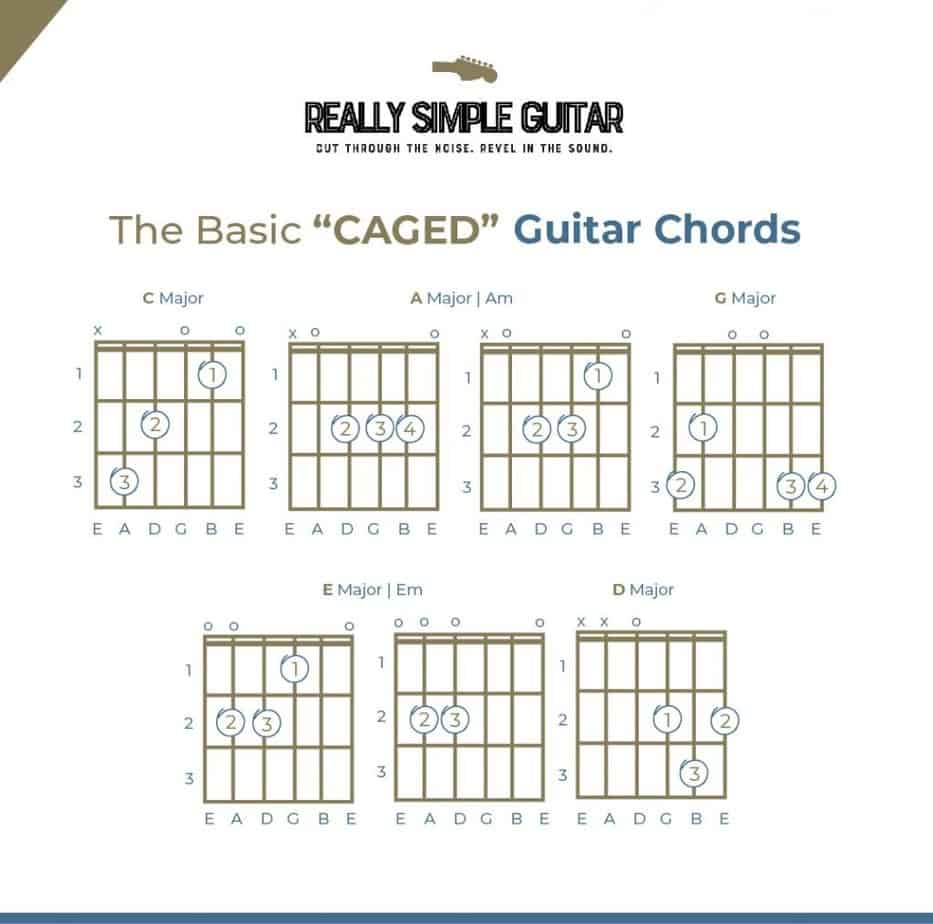
The first thing a new guitar player must learn is to see patterns. The second is to know it isn’t as hard as it seems. Keep it simple.
With those five initial beginner guitar chords, you have the shapes to create the remaining basic chords.
How to Read Guitar Chord Charts
If you were dumbfounded by the chart showing the beginner guitar chords above, don’t worry. Reading a guitar chord chart — also called a chord diagram — is easier than it looks at first glance. As long as you orient the map.
Flip the diagram on its side. Start reading from left to right as if you’re looking down at the guitar. Left to right, the vertical lines represent the strings. E, A, D, G, b, e. The horizontal lines of the grid represent the frets.
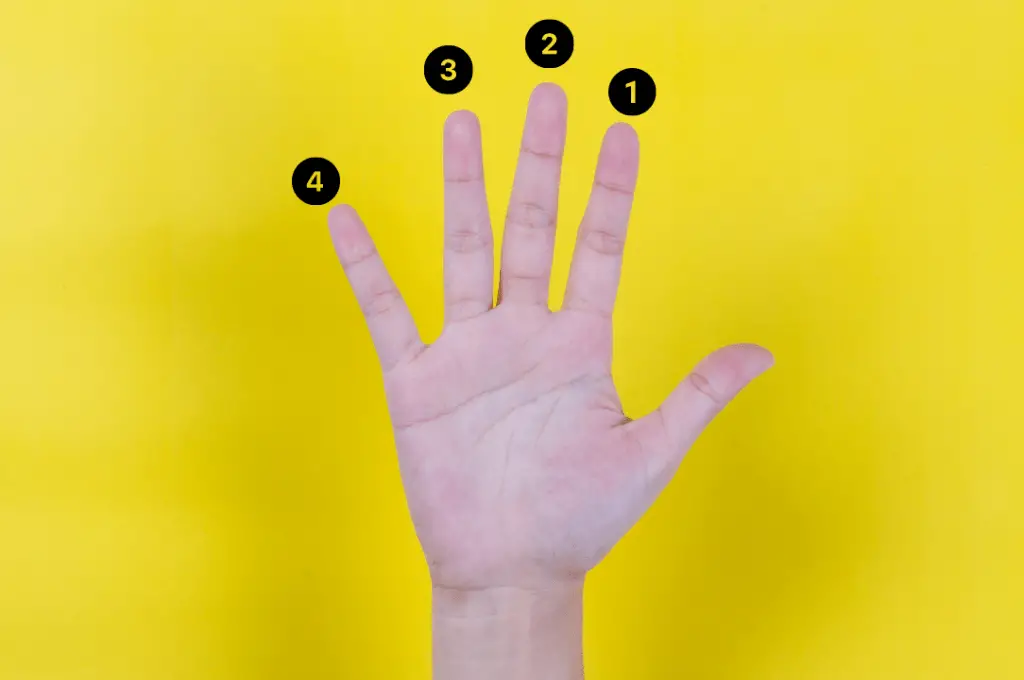
Next, your fretting fingers.
- 1 – Pointer finger.
- 2 – Middle finger.
- 3 – Ring finger.
- 4 – Pinky finger.
The numbers on the frets will tell you which finger to place there. If there isn’t a number on the fret, check the top of the chart. If there’s an “o” then play the string open. If there’s an “x,” don’t play that string.
Sound Better Faster

You will thank me when learning F Major that you learned these seven guitar chords first. F major is scary when you’re self-taught.
The “traditional” barre chord method wants you to change your hand’s basic structural interaction with the fretboard.
Making a big change like that is jarring. But when you look at an F major more like an open C major, well, you’re sure to sleep better.
Tips to Learn Chords Right
Once you know what to do, it’s simply a matter of putting in the work. Simple, consistent effort is key to progression.
I’ve rounded up a few tips from my self-taught experience that should help you on your guitar-playing journey.
Understand Major vs. Minor Chords
Your music theory lesson: A major chord and a minor chord have two things in common: The 1st and 5th degrees of the scale. The big difference between the two that can radically alter the sound of the song is the 3rd degree of the scale. Minor chords sound sad and even mysterious. Major chords sound bright and complete.
Let’s use the D major chord as an example. The root, or 1st note, is the D; the 3rd is F#; and the 5th is the A. (This is one of the first beginner guitar chords you should learn, by the way!)
The D minor chord also contains the D as the root and the A as the 5th. The difference, again, is the 3rd. To create a minor chord, you take the 3rd down a half step. So, in the case of a D minor, you’ll drop the F# to an F.
Open vs. Barre Chords
Open chords are shaped with open strings in them, commonly on the lower frets — those closer to the guitar’s nut. Refer to the chord chart above.
Barre chords require your index finger to hold down all strings across a particular fret and use your remaining fingers to either (typically) shape an E or A chord.
Learn on Acoustic

This is known as the “Dylan Method.”
It’s not, I just made that up. But it certainly was a big deal when Dylan went electric (1). He got booed. Booed! Dylan!
You don’t need to start playing an expensive Les Paul out of the gate because your hero does. Play the field. Progress from cheap to lifetime partner.
Learn on an acoustic first. It’s a complete-package instrument. An acoustic guitar is also its own amp. Its own projection. You only need an acoustic to perform.
Acoustics have the added benefit of improving your fretboard basics. You’ll learn to shape your chords more accurately when you aren’t covering mistakes with an overdriven amp.
If you have the chance, start on a classical acoustic guitar. The fretboard is a touch larger which encourages your dexterity. The nylon strings are more forgiving on virgin fingertips.
Make it Relevant Early
Take beginner guitar chords out of the classroom and into the streets as early as possible. Remember, learning easy guitar chords allow you to play easy beginner songs that you enjoy.
Nothing feels more accomplished than making something you recognize as music with this collection of wood and wires.
Take Guitar Lessons
Sure, you can study chord diagrams, but most beginner guitarists see value in taking lessons. Thankfully, there are plenty of online guitar lessons you can take advantage of at subscription rates that are well worth the money. I recommend committing to lessons for at least 6 months to give the guitar — and learning beginner guitar chords — an honest attempt.
Change Up Your Practice Sessions
Malcom Gladwell popularized the idea that you’ll be great at something if you practice it for 10,000 hours.
When it comes to learning these beginner chords, that’s no fun. That’s just too much time. Then again, learning the guitar does take time.
Thankfully, researchers at Johns Hopkins (2) found you can shorten that time and learn faster if you change up the way you’re practicing. Just a little.
Instead of playing the same songs over and over until you get it right, play other songs with the same chords. Do similar chord progression exercises. Add more context that is fun into the mix.
Not only will you learn faster, anyone who is near you while you’re learning will appreciate your switching it up.
Exercises to Help with Basic Guitar Chords
Now that you’ve got your ax picked out and have a strategy for how you’re going to attack it, it’s time to sit down and actually play. Here are some basic exercises to keep in mind as you progress in your playing.
Don’t Neglect Your Strumming Hand
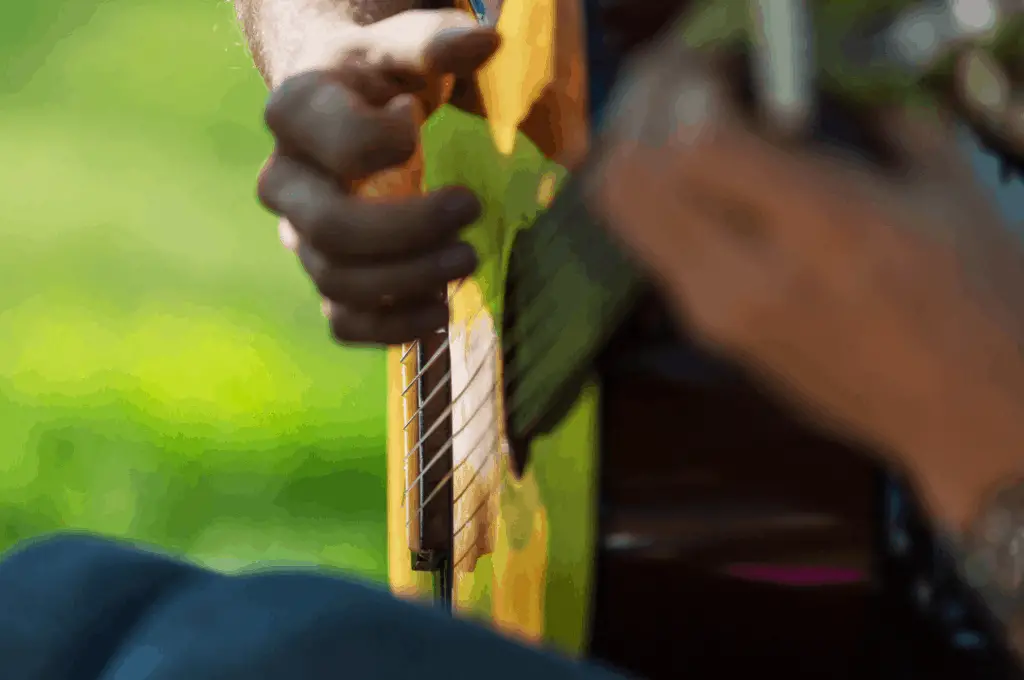
A lot of attention is paid rightly to the hand on the fretboard, but that doesn’t mean you can ignore your strumming hand.
Trust me, from experience, learn to use your strumming hand effectively now, while you’re learning your first few chords. It takes no extra time and it is much harder to learn later.
Switch up your practice sessions with some of these skills:
- Fingerpicking. Instead of strumming your chord changes, stay on one chord and pick the individual notes with your dominant hand. Choose different patterns until you can replicate them with ease. These arpeggios will help your soloing down the line.
- Copy strum patterns. Listen to your favorite songs not just for the chord changes but for the rhythmic strum patterns they’re playing. You can do this with a capo or mute on your fretboard to not disturb anyone around you.
- Play to a metronome. You should always be developing the ability to play on time. Your future bandmates will thank you.
Keep Practicing

Learning chords is a very early step down a very long road. As you learn, the most important concept to remember is to keep playing enjoyable. Once you make the basic chords breakthrough, a new musical landscape opens up. One that demands exploration.
In the meantime, rock on. Then be sure to check out our latest round-up of tips for learning guitar aimed at making your journey easier.
References:
- “Dylan goes electric at the Newport Folk Festival,” as published here: https://www.history.com/this-day-in-history/dylan-goes-electric-at-the-newport-folk-festival
- “Want to Learn a New Skill? Faster? Change Up Your Practice Sessions,” as published here: https://www.hopkinsmedicine.org/news/media/releases/want_to_learn_a_new_skill_faster_change_up_your_practice_sessions

